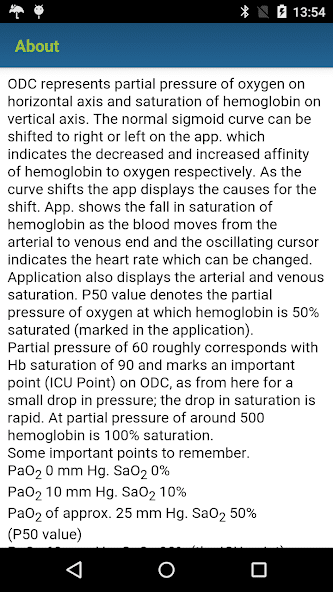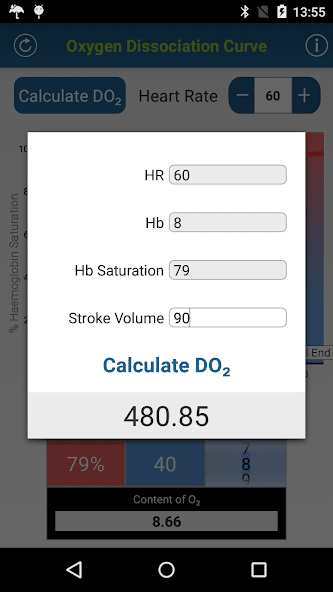ODC represents partial pressure of oxygen on horizontal axis and saturation of haemoglobin on vertical axis.
The normal sigmoid curve can be shifted to right or left on the app. which indicates the decreased and increased affinity of haemoglobin to oxygen respectively. As the curve shifts the app displays the causes for the shift.
App. shows the fall in saturation of haemoglobin as the blood moves from the arterial to venous end and the oscillating cursor indicates the heart rate which can be changed. Application also displays the arterial and venous saturation. P50 value denotes the partial pressure of oxygen at which haemoglobin is 50% saturated (marked in the application).
Partial pressure of 60 roughly corresponds with Hb saturation of 90 and marks an important point (ICU Point) on ODC, as from here for a small drop in pressure; the drop in saturation is rapid. At partial pressure of around 500 haemoglobin is 100% saturation.
Some important points to remember.
- PaO2 0 mm Hg. SaO2 0%
- PaO2 10 mm Hg. SaO2 10%
- PaO2 of approx. 25 mm Hg. SaO2 50% (P50 value)
- PaO2 60 mm Hg. SaO2 90% (the ICU point)
- PaO2 150 mm Hg. SaO2 98.8% shows flat upper part of ODC
- PaO2 500 mm Hg. SaO2 100%
Oxygen delivery (DO) can also be calculated in this app. DO2 largely depends on three parameters:
- 1. Hemoglobin concentration
- Saturation (SaO2)
- Cardiac Output (heart rate × stroke volume)
In this app. ENTER stroke volume in ml. and with values of saturation, PaO2 and Hb% already entered in the app, this app. will calculate the DO2 (ml/min).
The delivery of oxygen to the tissues per minute can be calculated as follows:
Step 1: Calculate amount of oxygen/100ml of blood (CaO2).
[(1.39 × Hb% × SaO2) ÷100 + (0.003 ×PaO2)]
Step 2: Calculate the cardiac output per minute = Heart rate × Stroke volume.
Step 3: Calculate the DO2
For example: Consider
Hb% = 15%
SaO2 = 100%
Cardiac output = 5L /min. (5000ml/ min.)
Step 1: Amount of oxygen/100 ml of blood = 20.88
Step 2: Cardiac output/min. = 5L/min. (given)
Step 3: DO2 = 20.88×5000 ÷ 100 = 1044 ml of O2/min.
Delivery of oxygen = 1044 ml of O2/min.
..(as per this example)
- Normal Cardiac output per minute
- Birth 400 ml / Kg / min
- Infancy onwards 200 ml / Kg / min
- Adolescents 100 ml / Kg / min.
- Stroke output = min output / Heart rate





